Ortiz de Montellano Paul R.(Ed.) Cytochrome P450. Structure, Mechanism, and Biochemistry
Подождите немного. Документ загружается.

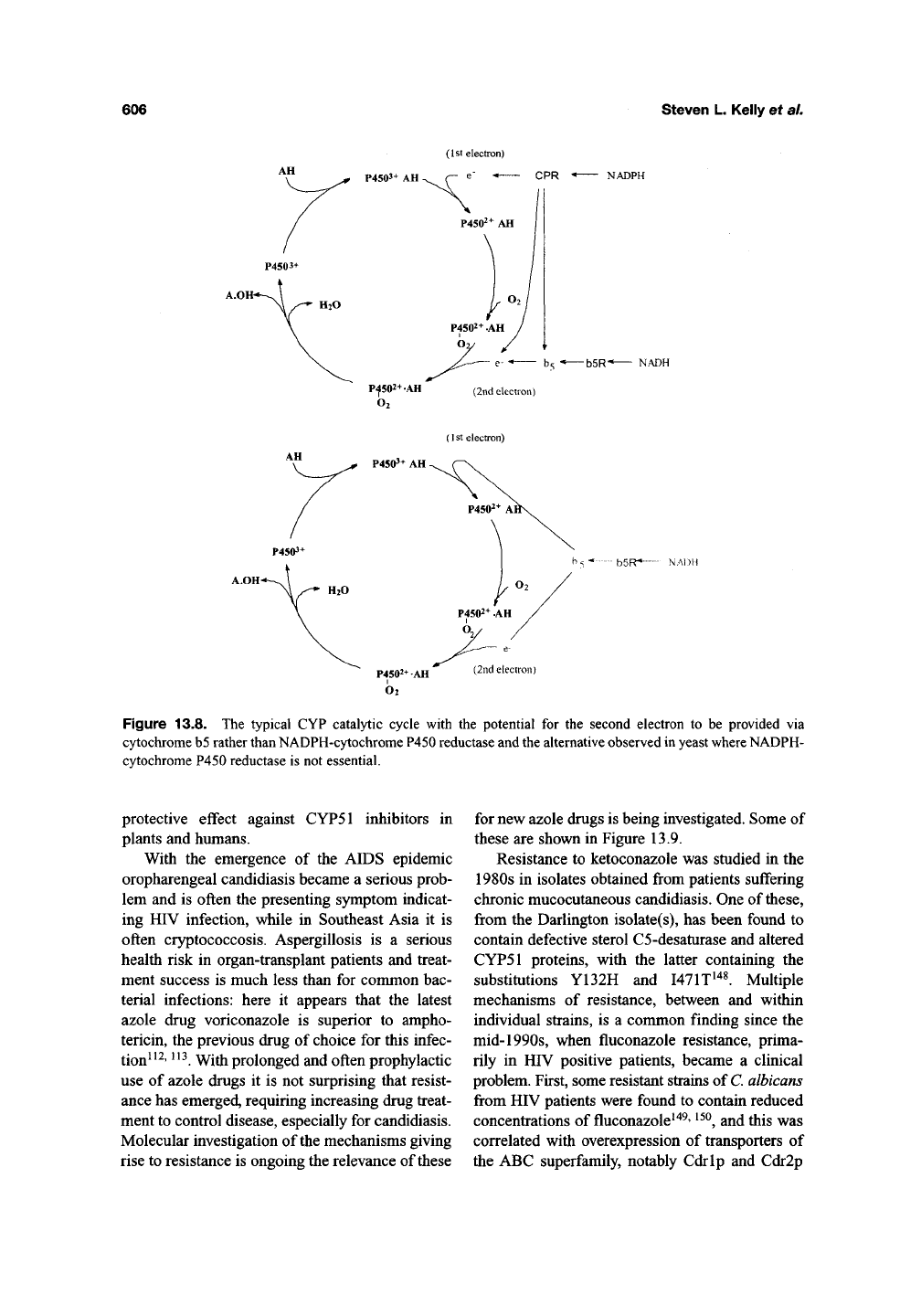
606
Steven L. Kelly et aL
(1st electron)
P4503+ AH
P^502+-AH (2ncl electron)
O2
(1st electron)
P45(h'+ AH
^5 ^ bSFT* NADIi
P4502+ -AH ^-^"^^ electron)
02
Figure 13.8. The typical CYP catalytic cycle with the potential for the second electron to be provided via
cytochrome
b5
rather
than
NADPH-cytochrome
P450
reductase and
the
alternative observed
in yeast where
NADPH-
cytochrome P450 reductase is not essential.
protective effect against CYP51 inhibitors in
plants and humans.
With the emergence of the AIDS epidemic
oropharengeal candidiasis became a serious prob-
lem and is often the presenting symptom indicat-
ing HIV infection, while in Southeast Asia it is
often cryptococcosis. Aspergillosis is a serious
health risk in organ-transplant patients and treat-
ment success is much less than for common bac-
terial infections: here it appears that the latest
azole drug voriconazole is superior to ampho-
tericin, the previous drug of choice for this infec-
tion^^^'
^^^.
With prolonged and often prophylactic
use of azole drugs it is not surprising that resist-
ance has emerged, requiring increasing drug treat-
ment to control disease, especially for candidiasis.
Molecular investigation of the mechanisms giving
rise to resistance is ongoing the relevance of these
for new azole drugs is being investigated. Some of
these are shown in Figure 13.9.
Resistance to ketoconazole was studied in the
1980s in isolates obtained from patients suffering
chronic mucocutaneous candidiasis. One of these,
from the Darlington isolate(s), has been found to
contain defective sterol C5-desaturase and altered
CYP51 proteins, with the latter containing the
substitutions Y132H and MTIT^^^ Multiple
mechanisms of resistance, between and within
individual strains, is a common finding since the
mid-1990s, when fluconazole resistance, prima-
rily in HIV positive patients, became a clinical
problem. First, some resistant strains of C albicans
from HIV patients were found to contain reduced
concentrations of fluconazole ^^^' ^^^, and this was
correlated with overexpression of transporters of
the ABC superfamily, notably Cdrlp and Cdr2p
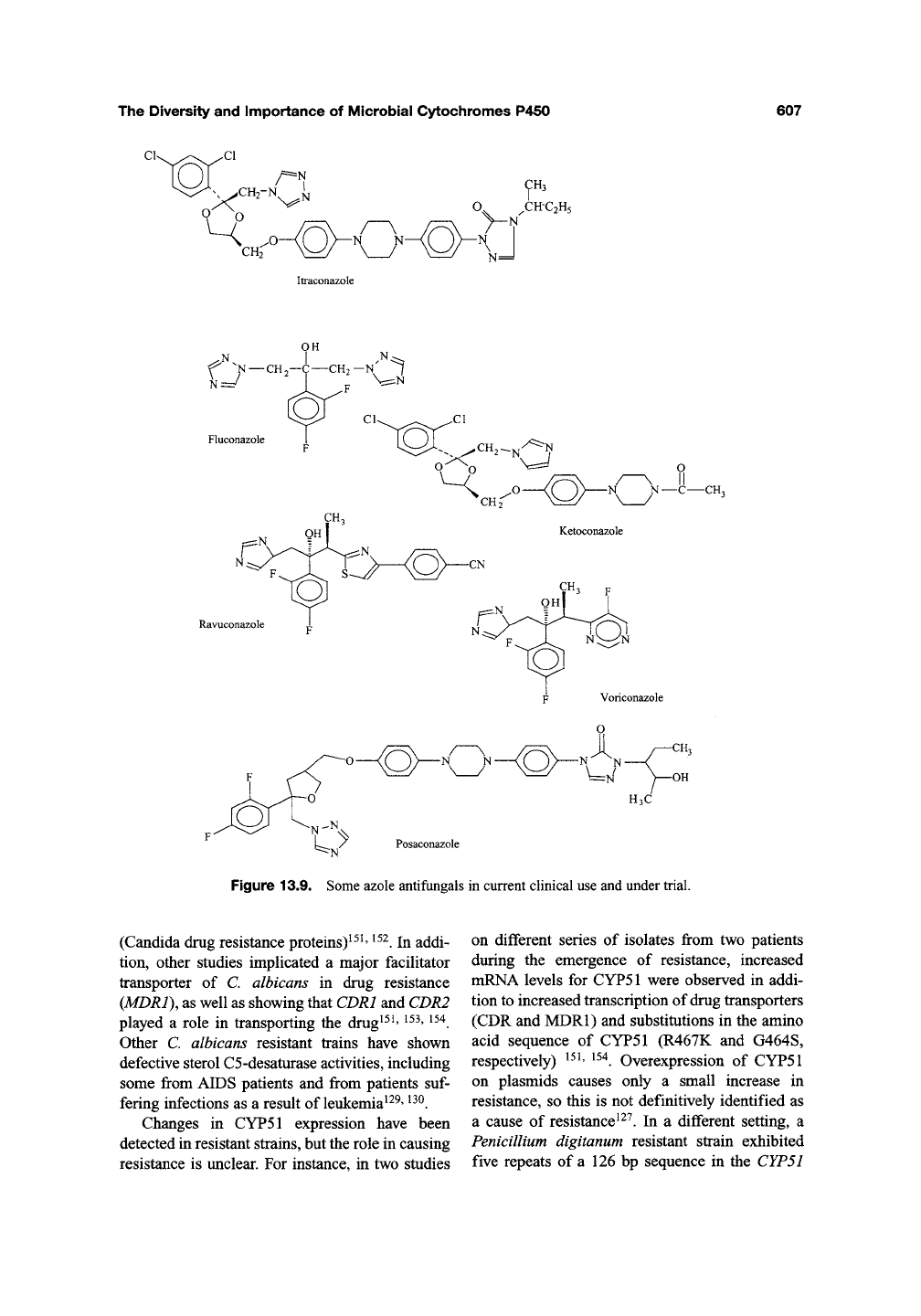
The Diversity and importance of iS^icrobiai Cytocliromes P450
607
0 o
,CH2-N J,
\ y y—V ,—V ,—. -y—n
CH3
,CH-C2H5
OH
/N I ,N
K' "N—CH,—C CH2—N 7
N
Fluconazole
Ravuconazole
^CH,~^^,/^N
Ketoconazole
L^ / Posaconazole
Figure 13.9. Some azole antifungals in current clinical use and under trial.
(Candida drug resistance proteins)^^^'
^^^.
In addi-
tion, other studies implicated a major facilitator
transporter of C albicans in drug resistance
{MDR1\
as well as showing that CDRl and CDR2
played a role in transporting the drug^^^' ^^^' ^^'*.
Other C albicans resistant trains have shown
defective sterol C5-desaturase activities, including
some from AIDS patients and from patients
suf-
fering infections as a result of leukemia^^^' ^^^.
Changes in CYP51 expression have been
detected in resistant strains, but the role in causing
resistance is unclear. For instance, in two studies
on different series of isolates from two patients
during the emergence of resistance, increased
mRNA levels for CYP51 were observed in addi-
tion to increased transcription of drug transporters
(CDR and MDRl) and substitutions in the amino
acid sequence of CYP51 (R467K and G464S,
respectively) ^^^'
^^^.
Overexpression of CYP51
on plasmids causes only a small increase in
resistance, so this is not definitively identified as
a cause of resistance ^^^. In a different setting, a
Penicillium digitanum resistant strain exhibited
five repeats of a 126 bp sequence in the CYP51

608
Steven L. Kelly et al.
promoter of a resistant strain, in comparison to
one in a sensitive strain, and this may represent a
resistance mechanism that results in enhanced
CYP51 expression^^^. A. fumigatus has two
CYP51 genes, as in other aspergilH^^^, and this
could also be the mechanism that makes it insen-
sitive to fluconazole, although itraconazole resist-
ance in A. fumigatus may be the result of
mechanisms similar to those described in more
detail here for C albicans^^^.
An isolate of
S.
cerevisiae, SGI, defective in
sterol C14-demethylation, contained the substitu-
tion G310H, had an inactive protein, and was
azole resistant^ ^^. The resistance was due to
the second sterol C5-desaturase defect of the
strain that suppressed the effect of the block
in 14-demethylation. 14-Methyl-ergosta-24,(28)-
dien-3,6-diol normally accumulates when 14-
demethylation is blocked, but with a second defect
in 5-desaturation, the functional sterol 14-
methylfecosterol accumulates instead^^^. Other
circumstantial evidence for mutant CYP51 result-
ing in azole resistance was observed^^^, but it was
not until 1997 that the first published evidence of
changes in C. albicans CYP51 as a cause of resist-
ance in practical settings appeared. These were
reported for laboratory studies that had indicated
that the change T315A in C albicans CYP51
could alter fluconazole resistance when expressed
in S. cerevisiae^^^. However, in a study of 18
resistant and 18 fluconazole resistant C albicans
isolates, a number of amino acid substitutions
were observed in the resistant cohort suggestive
of a causal link (Table 13.5). These included the
change G464S observed in many subsequent
investigations'^^ One particular problem was the
absence of a parental isolate to compare resistant
strains to, but a number of studies allowed
sequential sets to be investigated that were
obtained during the treatment of
a
patient and the
emergence of resistance. In one set of
17
isolates,
a number of molecular changes were observed,
including increased transcription of Cdrlp ABC
transporter that can confer cross-resistance to
other azoles, and of Mdrlp, a major facilitator
transporter, that confer fluconazole resistance'^'.
During the study, increased transcript levels of
CYP51 were also observed in later isolates.
Furthermore, the substitution R467K in CYP51
produced an active protein with reduced affinity
for fluconazole, as demonstrated by in vitro sterol
Table 13.5. A List of Amino acid
Substitutions Observed in CYP51 Among
Clinical Fluconazole Resistant Candida albicans
CYP51 substitution
F72L
F105L
D116E
F126L
K128T
G129A
Y132H
K143E
A149 V
D153E
E165Y
T229A
E266Q
E266D
S279Y
K287R
G307S
S405Y
S405F
V437I
G448E
F449L
G450E
V452A
G464S
G465S
R467K
147 IT
V488I
References
FsvrQetai, 1999
Loefflere/fl/., 1997
FavTQetal., 1999
FsLYTQetai,
1999
Sanglarde^fl/., 1998
Sanglard
etal,
1998
Sanglarde/fl/., 1998
FsiYTQetal.,
1999
Marichal etai, 1999
Marichale^a/., 1999
MahchsAetaL, 1999
FawQetai, 1999
Sanglarde/fl/., 1998
Locmcr
etal.,
1997
Fa\TQetal., 1999
Marichale^fl/., 1999
Loefflere/a/., 1997
Pereae^fl/.,2001
Favre
etal.,
1999
Sanglarde^fl/., 1998
Fawre
etal.,
1999
Sanglard
etal.,
1998
FavTQetaL,
1999
Loefflere/a/., 1997
FavrQetaL, 1999
Loefflere/a/., 1997
Marichale/a/., 1999
Loefflere/fl/., 1997
Sanglard
etal.,
1998
Marichale/fl/., 1999
Loemer etai, 1997
Marichale/a/., 1999
White, 1997
Sanglard
etal.,
1998
Kakeyae^«/.,2000
Loemcr
etal.,
1997
Notes: Not all these changes are known to cause resistance and
only Y132H, G464S, and R467K have been subject to investiga-
tion at the level of protein.
biosynthesis in cell-free extracts and later in stud-
ies on the protein after expression in
S.
cerevisiae^^^.
Another matched-set of C. albicans detected the
appearance of G464S during the emergence of
resistance^^'*. As noted by White ^^^ and Loeffler
et al}^^ the presence of homozygosity in this
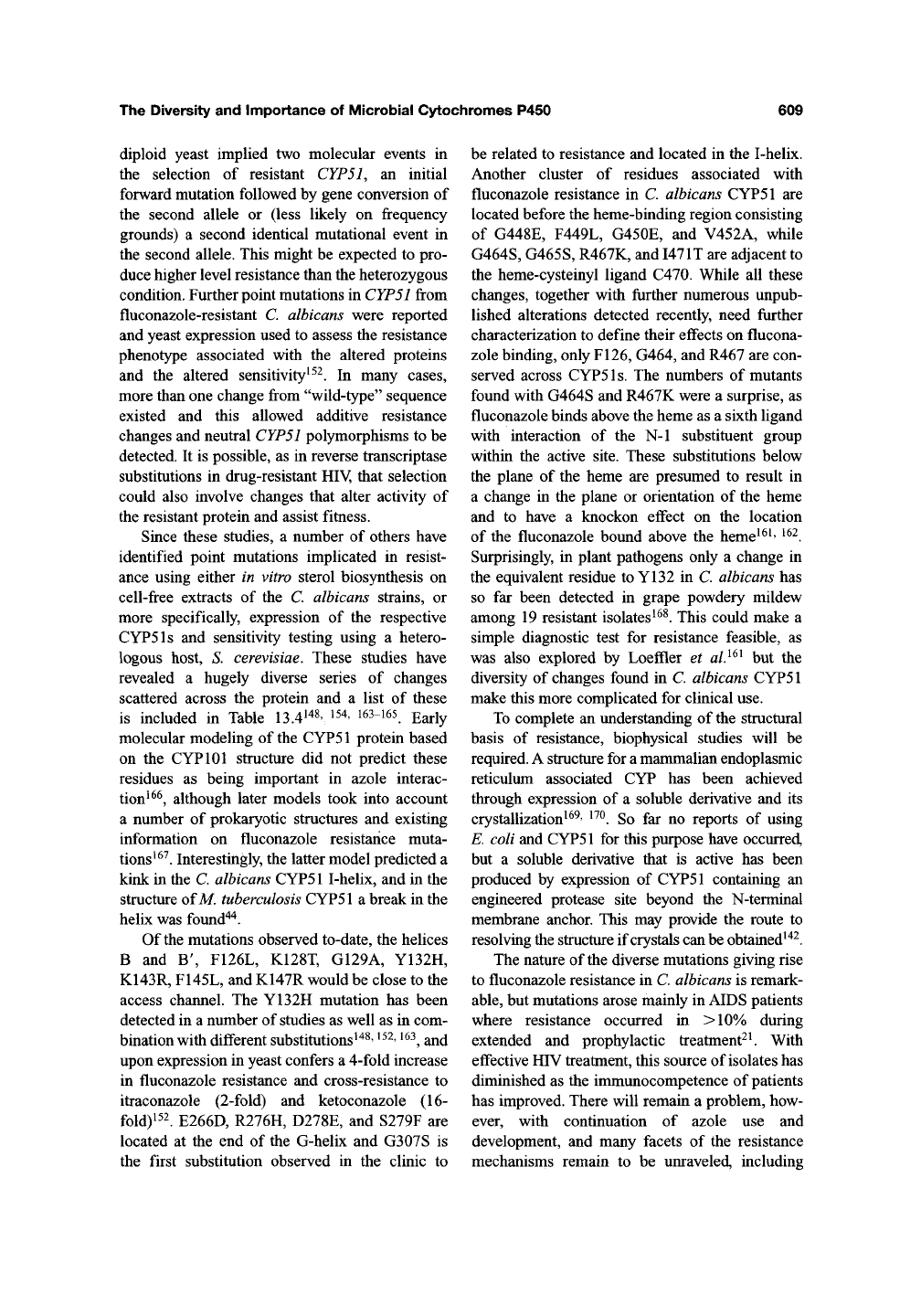
The Diversity and Importance of Microbial Cytochromes P450
609
diploid yeast implied two molecular events in
the selection of resistant CYP51, an initial
forward mutation followed by gene conversion of
the second allele or (less likely on frequency
grounds) a second identical mutational event in
the second allele. This might be expected to pro-
duce higher level resistance than the heterozygous
condition. Further point mutations in CYP51 from
fluconazole-resistant C. albicans were reported
and yeast expression used to assess the resistance
phenotype associated with the altered proteins
and the altered sensitivity^ ^^. In many cases,
more than one change from "wild-type" sequence
existed and this allowed additive resistance
changes and neutral CYP51 polymorphisms to be
detected. It is possible, as in reverse transcriptase
substitutions in drug-resistant HIV, that selection
could also involve changes that alter activity of
the resistant protein and assist fitness.
Since these studies, a number of others have
identified point mutations implicated in resist-
ance using either in vitro sterol biosynthesis on
cell-free extracts of the C. albicans strains, or
more specifically, expression of the respective
CYPSls and sensitivity testing using a hetero-
logous host, S. cerevisiae. These studies have
revealed a hugely diverse series of changes
scattered across the protein and a list of these
is included in Table 13.4i48, i54, i63-i65 g^rly
molecular modeling of the CYP51 protein based
on the CYPlOl structure did not predict these
residues as being important in azole interac-
tion^ ^^, although later models took into account
a number of prokaryotic structures and existing
information on fluconazole resistance muta-
tions
^^^.
Interestingly, the latter model predicted a
kink in the C. albicans CYP51 I-helix, and in the
structure of M tuberculosis CYP51 a break in the
helix was found"^^.
Of
the
mutations observed to-date, the helices
B and B', F126L, K128T, G129A, Y132H,
K143R, F145L, and K147R would be close to the
access channel. The Y132H mutation has been
detected in a number of studies as well as in com-
bination with different substitutions^^^'
^^^' ^^^,
and
upon expression in yeast confers a 4-fold increase
in fluconazole resistance and cross-resistance to
itraconazole (2-fold) and ketoconazole (16-
fold)i52 E266D, R276H, D278E, and S279F are
located at the end of the G-helix and G307S is
the first substitution observed in the clinic to
be related to resistance and located in the I-helix.
Another cluster of residues associated with
fluconazole resistance in C albicans CYP51 are
located before the heme-binding region consisting
of G448E, F449L, G450E, and V452A, while
G464S,
G465S, R467K, and I471T are adjacent to
the heme-cysteinyl ligand C470. While all these
changes, together with fiirther numerous unpub-
lished alterations detected recently, need fiirther
characterization to define their effects on flucona-
zole binding, only F126, G464, and R467 are con-
served across CYPSls. The numbers of mutants
found with G464S and R467K were a surprise, as
fluconazole binds above the heme as a sixth ligand
with interaction of the N-1 substituent group
within the active site. These substitutions below
the plane of the heme are presumed to result in
a change in the plane or orientation of the heme
and to have a knockon effect on the location
of the fluconazole bound above the heme^^^' ^^^.
Surprisingly, in plant pathogens only a change in
the equivalent residue to Y132 in C. albicans has
so far been detected in grape powdery mildew
among 19 resistant isolates ^^^. This could make a
simple diagnostic test for resistance feasible, as
was also explored by Loeffler et al}^^ but the
diversity of changes found in C albicans CYP51
make this more complicated for clinical use.
To complete an understanding of the structural
basis of resistance, biophysical studies will be
required. A structure for a mammalian endoplasmic
reticulum associated GYP has been achieved
through expression of a soluble derivative and its
crystallization^ ^^' ^^^. So far no reports of using
E. coli and CYP51 for this purpose have occurred,
but a soluble derivative that is active has been
produced by expression of CYP51 containing an
engineered protease site beyond the N-terminal
membrane anchor. This may provide the route to
resolving the structure if crystals can be obtained^^^.
The nature of the diverse mutations giving rise
to fluconazole resistance in C. albicans is remark-
able,
but mutations arose mainly in AIDS patients
where resistance occurred in >10% during
extended and prophylactic treatment^ ^ With
effective HIV treatment, this source of isolates has
diminished as the immunocompetence of patients
has improved. There will remain a problem, how-
ever, with continuation of azole use and
development, and many facets of the resistance
mechanisms remain to be unraveled, including

610
Steven L. Kelly et a/.
precise roles and effects of the diverse mutations
in CYP5L
Council, Natural and Environmental Research
Council, The Wellcome Trust, and The Wolfson
Foundation.
8. Conclusions
Microbial CYP biodiversity is presenting an
unexpected challenge as the numbers of CYPs
uncovered makes functional investigation through
high-throughput genomics mandatory in addition to
the more traditional, but essential approaches. The
most facile organisms to study are the model organ-
isms with well-established genetic systems, but
many of
the
most interesting in terms of their CYP
complements and environmental relevance, such as
P.
chrysosporium, will be important to tackle even
if more recalcitrant. With many CYPs involved
in metabolic pathways, an emphasis on changing
CYPs to alter end-products will emerge. One of the
most ambitious metabolic engineering projects to
date involved the diversion of yeast ergosterol
biosynthesis toward corticosteroid production,
which involved deleting and adding CYPs to trans-
genic yeast^^. Coupled to the ability to improve
enzymes through processes of directed evolution,
much will be possible in pathway improvement and
invention as well as in biocatalysis^^^
Comparative genomics between close species
and within strains will add to our information
on the biological roles and evolution of CYPs.
Contributions from currently unrepresented
organisms from the fungi, protista, and algae will
be of great interest in understanding CYP evolu-
tion. With 42 CYPs already detected in the slime-
mould Dictyostelium discoidium, other protists
are likely to have large numbers of
CYPs.
Where
they are pathogenic, such as Leischmeinia and
Trypanosoma, there will be the added interest of
developing drugs to target these diseases via CYP
inhibition, and azoles are already being used. The
huge wave of CYP information from these pro-
jects will provide a major impetus to finding ways
of establishing function and biotechnological uses
in a systematic manner.
Acknowledgments
Research in the Wolfson Laboratory of P450
Biodiversity is currently supported by the
Biotechnology and Biological Science Research
References
1.
Klingenberg, M. (1958). Pigments of rat liver
microsomes.
Arch.
Biochem.
Biophys.
75,
376-386.
2.
Omura,
T.
and
R.
Sato
(1962).
A new
cytochrome in
liver microsomes,
o^
Biol.
Chem.
237, 1375-1376.
3.
Estabrook, R.W., D.Y. Cooper, and O. Rosenthal
(1963).
The light reversible carbon monoxide inhi-
bition of the steroid C21-hydroxylase system of the
adrenal cortex.
Biochem.
Z.
338, 741.
4.
Lu, A.YH., K.W. Junk, and M.J. Coon (1969).
Resolution of the cytochrome P450 in fatty acid
w-hydroxylation system into three components.
J.
Biol.
Chem.
243, 1331-1332.
5.
Hanukoglu, I. (1992). Steroidogenic enzymes:
Structure, function and regulation of expression.
J.
Steroid
Biochem.
Mol.
Biol.
43, 779-804.
6. Lindenmeyer, A. and L. Smith (1964).
Cytochromes and other pigments of bakers yeast
grown aerobically and anaerobically. Biochem.
Biophys.
Acta.
93,
445-^61.
7.
Appleby, C.A. (1967). A soluble haemoprotein
P450 from nitrogen-fixing rhizobium bacteroids.
Biochem.
Biophys.
Acta.
147, 399-^02.
8. Katagiri, M., B.N. Ganguli, and I.C. Gunsalus
(1968).
A soluble cytochrome P450 functional
in methylene hydroxylation. J. Biol.
Chem.
243,
3543-3546.
9. Tyson, C.A., J.D. Lipscomb, and I.C. Gunsalus
(1972).
The role of putidaredoxin and P450 cam in
methylene hydroxylation. J. Biol. Chem. 247,
5777-5784.
10.
Rheinwald, J.G., A.M. Chakrabarty, and I.C.
Gunsalus (1973). A transmissible plasmid control-
ling camphor oxidation in
Pseudomonas
putida.
Proc.
Natl.
Acad
Sci.
USA
70, 885-889.
11.
Sligar, S.G., RG. Debrunner, J.D. Lipscomb, M.J.
Namtvedt, and I.C. Gunsalus (1974). A role of
the putidaredoxin COOH-terminus in P-450cam
(cytochrome m) hydroxylations.
Proc.
Natl.
Acad.
Sci. t/^^
71,
3906-3910.
12.
Koga, H., B. Rauchfuss, and I.C. Gunsalus
(1985).
P450cam gene cloning and expression in
Pseudomonas putida and Escherichia coli.
Biochem.
Biophys.
Res.
Commun.
130, 412-417.
13.
Narhi, L.O. and A.J. Fulco (1982). Phenobarbital
induction of a soluble cytochrome P450 depend-
ent fatty acid monooxygenase from Bacillus
megaterium.
J.
Biol.
Chem.
257, 2147-2150.
14.
Kelly, S.L.,
D.C.
Lamb,
M.
Cannieux,
D.
Greetham,
C.J. Jackson, T. Marczylo et al. (2001). An old
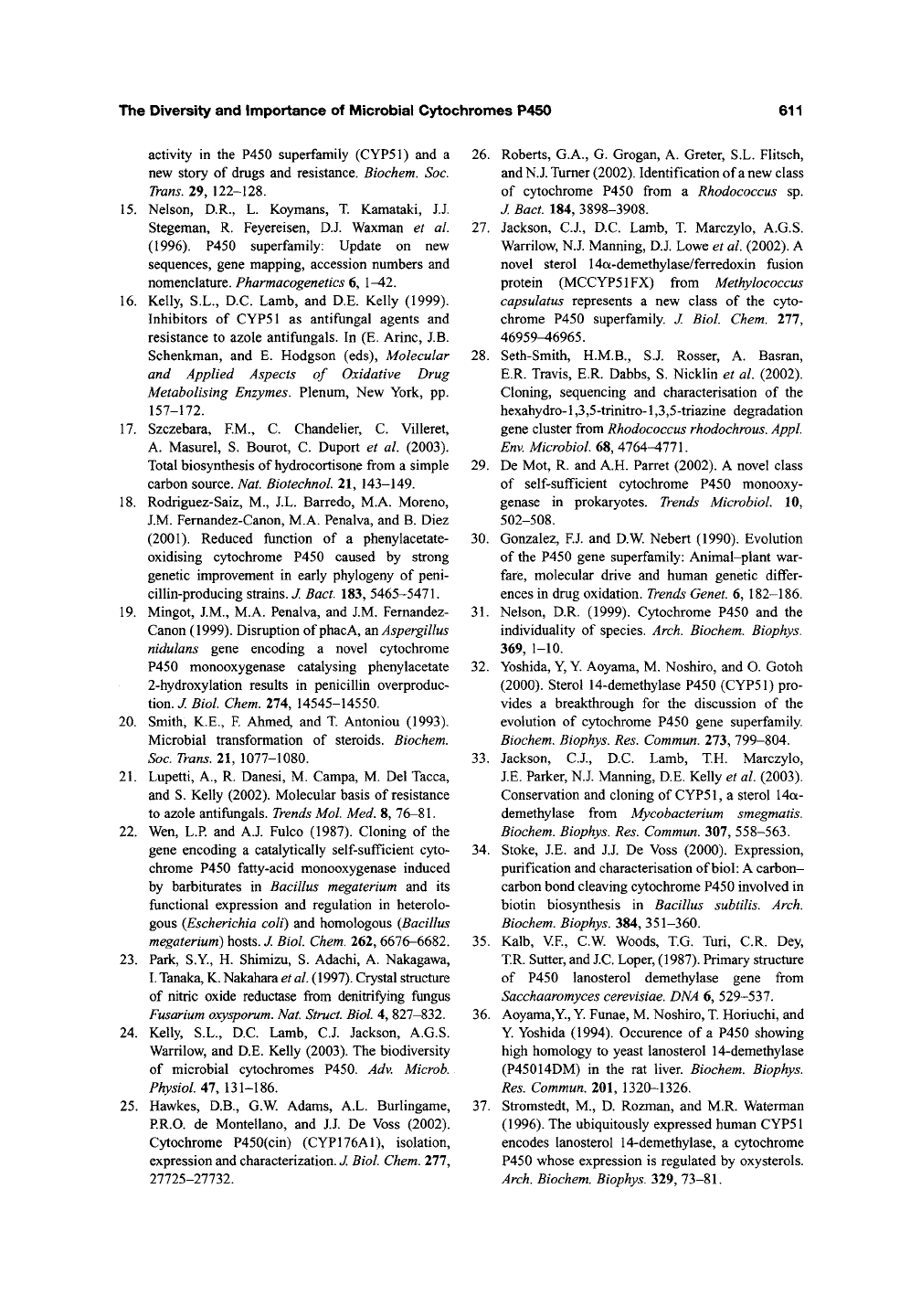
The Diversity and importance of IS^icrobiai Cytochromes P450 611
activity in the P450 superfamily (CYP51) and a
new story of drugs and resistance. Biochem. Soc.
Trans.
29, 122-128.
15.
Nelson, D.R., L. Koymans, T. Kamataki, J.J.
Stegeman, R. Feyereisen, D.J. Waxman et al.
(1996).
P450 superfamily: Update on new
sequences, gene mapping, accession numbers and
nomenclature. Pharmacogenetics 6, 1-42.
16.
Kelly, S.L., D.C. Lamb, and D.E. Kelly (1999).
Inhibitors of CYP51 as antifungal agents and
resistance to azole antifungals. In (E. Arinc, J.B.
Schenkman, and E. Hodgson (eds). Molecular
and Applied Aspects of Oxidative Drug
Metabolising Enzymes. Plenum, New York, pp.
157-172.
17.
Szczebara, P.M., C. Chandelier, C. Villeret,
A. Masurel, S. Bourot, C. Duport et al. (2003).
Total biosynthesis of hydrocortisone from a simple
carbon source. Nat. Biotechnol 21, 143-149.
18.
Rodriguez-Saiz, M., J.L. Barredo, M.A. Moreno,
J.M. Fernandez-Canon, M.A. Penalva, and B. Diez
(2001).
Reduced function of a phenylacetate-
oxidising cytochrome P450 caused by strong
genetic improvement in early phytogeny of peni-
cillin-producing strains. J. Bact. 183, 5465-5471.
19.
Mingot, J.M., M.A. Penalva, and J.M. Fernandez-
Canon (1999). Disruption of phacA,
diW
Aspergillus
nidulans gene encoding a novel cytochrome
P450 monooxygenase catalysing phenylacetate
2-hydroxylation results in penicillin overproduc-
tion. J. Biol. Chem. 214, 14545-14550.
20.
Smith, K.E., R Ahmed, and T. Antoniou (1993).
Microbial transformation of steroids. Biochem.
Soc. Trans. 21, 1077-1080.
21.
Lupetti, A., R. Danesi, M. Campa, M. Del Tacca,
and S. Kelly (2002). Molecular basis of resistance
to azole antifungals.
Trends
Mol. Med. 8,
76-81.
22.
Wen, L.R and A.J. Fulco (1987). Cloning of the
gene encoding a catalytically self-sufficient cyto-
chrome P450 fatty-acid monooxygenase induced
by barbiturates in Bacillus megaterium and its
functional expression and regulation in heterolo-
gous (Escherichia coli) and homologous {Bacillus
megaterium) hosts.
J.
Biol. Chem. 262, 6676-6682.
23.
Park, S.Y, H. Shimizu, S. Adachi, A. Nakagawa,
I.
Tanaka, K. Nakahara et
al.
(1997). Crystal structure
of nitric oxide reductase from denitrifying fungus
Fusarium
oxysporum.
Nat. Struct. Biol. 4, 827-832.
24.
Kelly, S.L., D.C. Lamb, C.J. Jackson, A.G.S.
Warrilow, and D.E. Kelly (2003). The biodiversity
of microbial cytochromes P450. Adv. Microb.
Physiol. 47, 131-186.
25.
Hawkes, D.B., G.W. Adams, A.L. Burlingame,
PR.O.
de Montellano, and J.J. De Voss (2002).
Cytochrome P450(cin) (CYP176A1), isolation,
expression and characterization.
J.
Biol. Chem. 277,
27725-27732.
26.
Roberts, G.A., G. Grogan, A. Greter, S.L. Flitsch,
and
N.J.
Turner (2002). Identification of a new class
of cytochrome P450 from a Rhodococcus sp.
J. Bact. 184, 3898-3908.
27.
Jackson, C.l, D.C. Lamb, T. Marczylo, A.G.S.
Warrilow, N.J. Manning, D.J. Lowe et al. (2002). A
novel sterol 14a-demethylase/ferredoxin fusion
protein (MCCYP51FX) from Methylococcus
capsulatus represents a new class of the cyto-
chrome P450 superfamily. J. Biol. Chem. Ill,
46959-^6965.
28.
Seth-Smith, H.M.B., S.J. Rosser, A. Basran,
E.R. Travis, E.R. Dabbs, S. Nicklin et al. (2002).
Cloning, sequencing and characterisation of the
hexahydro-1,3,5-trinitro-1,3,5-triazine degradation
gene cluster from Rhodococcus rhodochrous. Appl.
Env Microbiol. 68, 4764-^771.
29.
De Mot, R. and A.H. Parret (2002). A novel class
of self-sufficient cytochrome P450 monooxy-
genase in prokaryotes. Trends Microbiol. 10,
502-508.
30.
Gonzalez, FJ. and D.W. Nebert (1990). Evolution
of the P450 gene superfamily: Animal-plant war-
fare,
molecular drive and human genetic differ-
ences in drug oxidation. Trends Genet. 6, 182-186.
31.
Nelson, D.R. (1999). Cytochrome P450 and the
individuality of species. Arch. Biochem. Biophys.
369,
1-10.
32.
Yoshida, Y,
Y.
Aoyama, M. Noshiro, and O. Gotoh
(2000).
Sterol 14-demethylase P450 (CYP51) pro-
vides a breakthrough for the discussion of the
evolution of cytochrome P450 gene superfamily.
Biochem. Biophys. Res. Commun. 213, 799-804.
33.
Jackson, C.J., DC. Lamb, T.H. Marczylo,
J.E. Parker, N.J. Manning, D.E. Kelly et al. (2003).
Conservation and cloning of
CYP51,
a sterol 14a-
demethylase from Mycobacterium smegmatis.
Biochem. Biophys. Res. Commun. 307, 558-563.
34.
Stoke, J.E. and J.J. De Voss (2000). Expression,
purification and characterisation of biol: A carbon-
carbon bond cleaving cytochrome P450 involved in
biotin biosynthesis in Bacillus subtilis. Arch.
Biochem. Biophys. 384, 351-360.
35.
Kalb, VF, C.W Woods, T.G. Turi, C.R. Dey,
T.R. Sutter, and
J.C.
Loper, (1987). Primary structure
of P450 lanosterol demethylase gene from
Sacchaaromyces cerevisiae. DNA 6, 529-537.
36.
Aoyama,Y, Y Funae, M. Noshiro,
T.
Horiuchi, and
Y Yoshida (1994). Occurence of a P450 showing
high homology to yeast lanosterol 14-demethylase
(P45014DM) in the rat liver. Biochem. Biophys.
Res.
Commun. 201, 1320-1326.
37.
Stromstedt, M., D. Rozman, and M.R. Waterman
(1996).
The ubiquitously expressed human CYP51
encodes lanosterol 14-demethylase, a cytochrome
P450 whose expression is regulated by oxysterols.
Arch.
Biochem. Biophys. 329,
73-81.
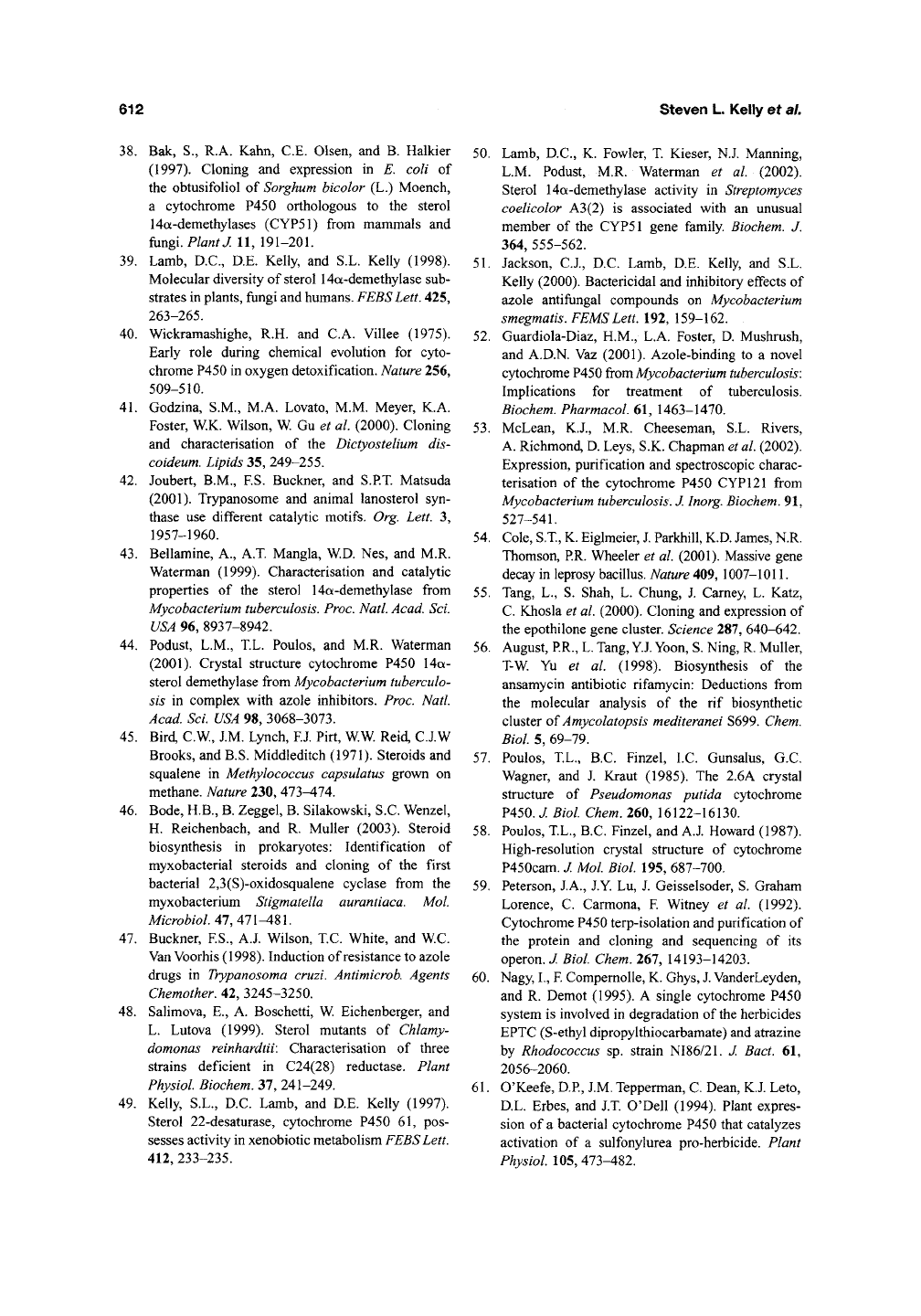
612
Steven L. Kelly et aL
38.
Bak, S., R.A. Kahn, C.E. Olsen, and B. Halkier
(1997).
Cloning and expression in E. coli of
the obtusifoliol of Sorghum bicolor (L.) Moench,
a cytochrome P450 orthologous to the sterol
14a-demethylases (CYP51) from mammals and
fmigl Plant
J.
n,
191-201.
39.
Lamb, D.C., D.E. Kelly, and S.L. Kelly (1998).
Molecular diversity of sterol 14a-demethylase sub-
strates in plants, fungi and humans. FEBSLett. 425,
263-265.
40.
Wickramashighe, R.H. and C.A. Villee (1975).
Early role during chemical evolution for cyto-
chrome P450 in oxygen detoxification. Nature 256,
509-510.
41.
Godzina, S.M., M.A. Lovato, M.M. Meyer, K.A.
Foster, W.K. Wilson, W. Gu et al (2000). Cloning
and characterisation of the Dictyostelium dis-
coideum. Lipids 35, 249-255.
42.
Joubert, B.M., ES. Buckner, and S.P.T. Matsuda
(2001).
Trypanosome and animal lanosterol syn-
thase use different catalytic motifs. Org. Lett. 3,
1957-1960.
43.
Bellamine, A., A.T. Mangla, W.D. Nes, and M.R.
Waterman (1999). Characterisation and catalytic
properties of the sterol 14a-demethylase from
Mycobacterium tuberculosis. Proc. Natl.
Acad.
Sci.
USA 96, 8937-8942.
44.
Podust, L.M., T.L. Poulos, and M.R. Waterman
(2001).
Crystal structure cytochrome P450 14a-
sterol demethylase from Mycobacterium tuberculo-
sis in complex with azole inhibitors. Proc. Natl.
Acad Sci. USA 98, 3068-3073.
45.
Bird, C.W, J.M. Lynch, RJ. Pirt, WW Reid, C.J.W
Brooks, and B.S. Middleditch (1971). Steroids and
squalene in Methylococcus capsulatus grown on
methane. Nature 230,
A12i-A1A.
46.
Bode, H.B., B. Zeggel, B. Silakowski, S.C. Wenzel,
H. Reichenbach, and R. Muller (2003). Steroid
biosynthesis in prokaryotes: Identification of
myxobacterial steroids and cloning of the first
bacterial 2,3(S)-oxidosqualene cyclase from the
myxobacterium Stigmatella aurantiaca. Mol.
Microbiol. 41,
47\^S\.
47.
Buckner, ES., A.J. Wilson, T.C. White, and WC.
Van Voorhis (1998). Induction of resistance to azole
drugs in Trypanosoma cruzi. Antimicrob. Agents
Chemother. 42, 3245-3250.
48.
Salimova, E., A. Boschetti, W Eichenberger, and
L. Lutova (1999). Sterol mutants of Chlamy-
domonas reinhardtii: Characterisation of three
strains deficient in C24(28) reductase. Plant
Physiol. Biochem. 37, 241-249.
49.
Kelly, S.L., D.C. Lamb, and D.E. Kelly (1997).
Sterol 22-desaturase, cytochrome P450 61, pos-
sesses activity in xenobiotic metabolism FEBSLett.
412,
233-235.
50.
Lamb, D.C, K. Fowler, T. Kieser, N.J. Manning,
L.M. Podust, M.R. Waterman et al. (2002).
Sterol 14a-demethylase activity in Streptomyces
coelicolor A3(2) is associated with an unusual
member of the CYP51 gene family. Biochem. J.
364,
555-562.
51.
Jackson, C.J., D.C. Lamb, D.E. Kelly, and S.L.
Kelly (2000). Bactericidal and inhibitory effects of
azole antifungal compounds on Mycobacterium
smegmatis. FEMS Lett. 192, 159-162.
52.
Guardiola-Diaz, H.M., L.A. Foster, D. Mushrush,
and A.D.N. Vaz (2001). Azole-binding to a novel
cytochrome P450 from Mycobacterium
tuberculosis:
Implications for treatment of tuberculosis.
Biochem. Pharmacol. 61, 1463-1470.
53.
McLean, K.J., M.R. Cheeseman, S.L. Rivers,
A. Richmond, D. Leys, S.K. Chapman etal. (2002).
Expression, purification and spectroscopic charac-
terisation of the cytochrome P450 CYP121 from
Mycobacterium tuberculosis.
J.
Inorg. Biochem. 91,
527-541.
54.
Cole, S.T., K. Eiglmeier, J. Parkhill,
K.D.
James, N.R.
Thomson, PR. Wheeler et al. (2001). Massive gene
decay in leprosy bacillus. Nature 409, 1007-1011.
55.
Tang, L., S. Shah, L. Chung, J. Carney, L. Katz,
C. Khosla et al. (2000). Cloning and expression of
the epothilone gene cluster. Science 287, 640-642.
56.
August, PR., L.
Tang,
Y.J.
Yoon, S. Ning, R. Muller,
T-W Yu et al. (1998). Biosynthesis of the
ansamycin antibiotic rifamycin: Deductions from
the molecular analysis of the rif biosynthetic
cluster of Amycolatopsis mediteranei S699. Chem.
Biol. 5, 69-79.
57.
Poulos, TL., B.C. Finzel, I.C. Gunsalus, G.C.
Wagner, and J. Kraut (1985). The 2.6A crystal
structure of Pseudomonas putida cytochrome
?450. J. Biol. Chem. 260, 16122-16130.
58.
Poulos, T.L., B.C. Finzel, and A.J. Howard (1987).
High-resolution crystal structure of cytochrome
P450cam. J. Mol. Biol. 195, 687-700.
59.
Peterson, J.A., J.Y Lu, J. Geisselsoder, S. Graham
Lorence, C. Carmona, F. Witney et al. (1992).
Cytochrome P450 terp-isolation and purification of
the protein and cloning and sequencing of its
oipQxon.
J. Biol. Chem. 267, 14193-14203.
60.
Nagy, I.,
F.
Compemolle, K. Ghys, J. VanderLeyden,
and R. Demot (1995). A single cytochrome P450
system is involved in degradation of
the
herbicides
EPTC (S-ethyl dipropylthiocarbamate) and atrazine
by Rhodococcus sp. strain
NI86/21.
J. Bact. 61,
2056-2060.
61.
O'Keefe, DP, J.M. Tepperman, C. Dean, K.J. Leto,
D.L. Erbes, and J.T. O'Dell (1994). Plant expres-
sion of a bacterial cytochrome P450 that catalyzes
activation of a sulfonylurea pro-herbicide. Plant
Physiol. 105, 473-482.
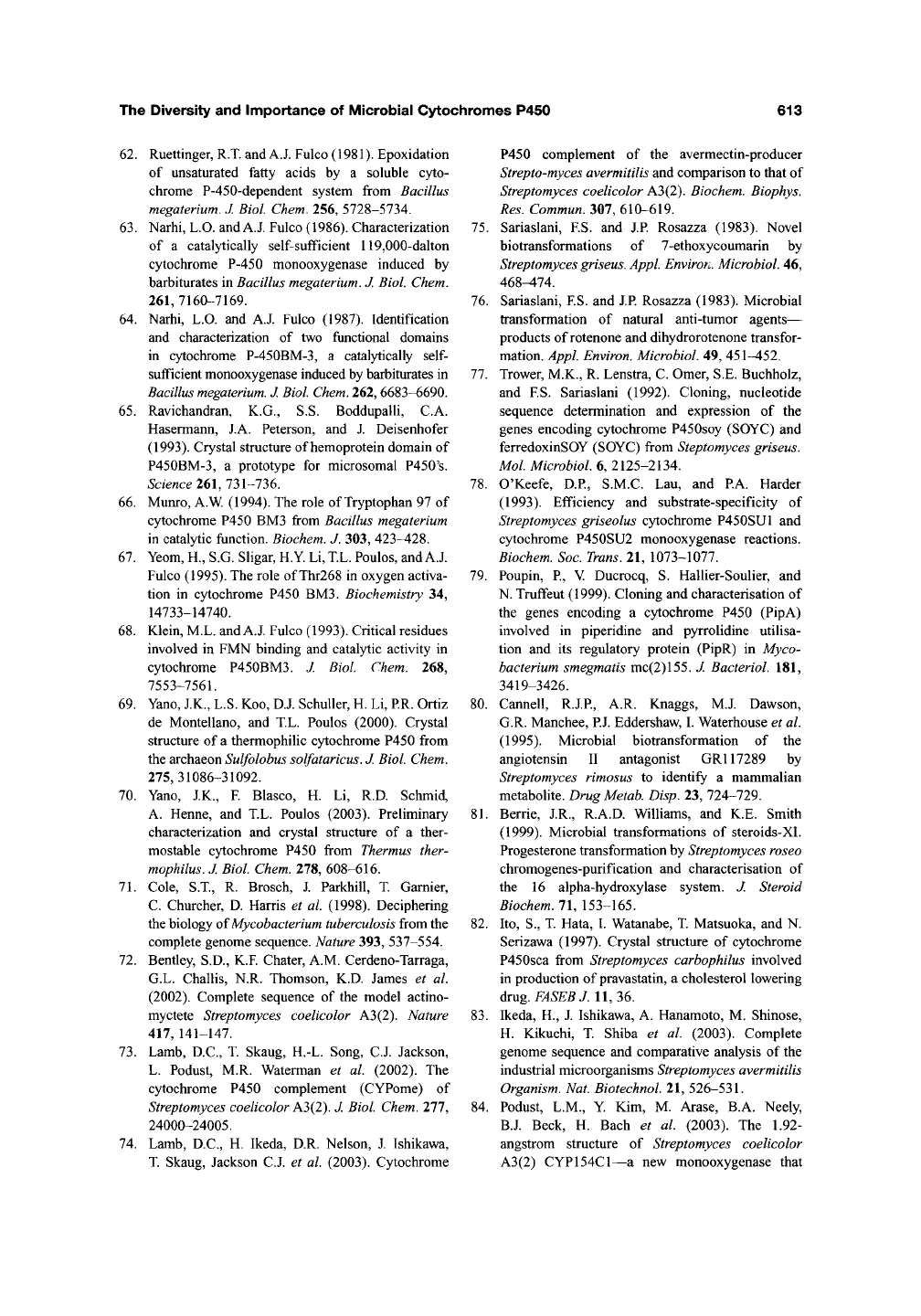
The Diversity and Importance of iVIicrobial Cytochromes P450 613
62.
Ruettinger, R.T. and
A.J.
Fulco (1981). Epoxidation
of unsaturated fatty acids by a soluble cyto-
chrome P-450-dependent system from Bacillus
megaterium. J. Biol. Chem. 256, 5728-5734.
63.
Narhi, L.O. and
A.J.
Fulco (1986). Characterization
of a catalytically self-sufficient 119,000-dalton
cytochrome P-450 monooxygenase induced by
barbiturates in Bacillus megaterium. J. Biol. Chem.
261,
7160-7169.
64.
Narhi, L.O. and A.J. Fulco (1987). Identification
and characterization of two functional domains
in cytochrome P-450BM-3, a catalytically
self-
sufficient monooxygenase induced by barbiturates in
Bacillus
megaterium.
J.
Biol.
Chem.
262, 6683-6690.
65.
Ravichandran, K.G., S.S. BoddupalH, C.A.
Hasermann, J.A. Peterson, and J. Deisenhofer
(1993).
Crystal structure of hemoprotein domain of
P450BM-3,
a prototype for microsomal P450's.
Science 16\,n\-12>6.
66.
Munro, A.W. (1994). The role of Tryptophan 97 of
cytochrome P450 BM3 from Bacillus megaterium
in catalytic function. Biochem. J. 303, 423^28.
67.
Yeom, H., S.G. Sligar, H.Y. Li, TL. Poulos, and A.J.
Fulco (1995). The role of Thr268 in oxygen activa-
tion in cytochrome P450 BM3. Biochemistry 34,
14733-14740.
68.
Klein, M.L. and
A.J.
Fulco (1993). Critical residues
involved in FMN binding and catalytic activity in
cytochrome P450BM3. J. Biol. Chem. 268,
7553-7561.
69.
Yano, J.K., L.S. Koo, D.J. SchuUer, H. Li, PR. Ortiz
de Montellano, and T.L. Poulos (2000). Crystal
structure of a thermophilic cytochrome P450 from
the archaeon Sulfolobus solfataricus.
J.
Biol. Chem.
275,31086-31092.
70.
Yano, J.K., F. Blasco, H. Li, R.D. Schmid,
A. Henne, and T.L. Poulos (2003). Preliminary
characterization and crystal structure of a ther-
mostable cytochrome P450 from Thermus ther-
mophilus. J. Biol. Chem. 278, 608-616.
71.
Cole, S.T, R. Brosch, J. Parkhill, T Gamier,
C. Churcher, D. Harris et al. (1998). Deciphering
the biology of Mycobacterium tuberculosis from the
complete genome sequence. Nature 393, 537-554.
72.
Bentley, S.D., K.F Chater, A.M. Cerdeno-Tarraga,
G.L. Challis, N.R. Thomson, K.D. James et al.
(2002).
Complete sequence of the model actino-
myctete Streptomyces coelicolor A3(2). Nature
417,141-147.
73.
Lamb, D.C., T. Skaug, H.-L. Song, C.J. Jackson,
L. Podust, M.R. Waterman et al (2002). The
cytochrome P450 complement (CYPome) of
Streptomyces coelicolor
A3(2).
J. Biol. Chem. Ill,
24000-24005.
74.
Lamb, D.C., H. Ikeda, D.R. Nelson, J. Ishikawa,
T. Skaug, Jackson C.J. et al. (2003). Cytochrome
P450 complement of the avermectin-producer
Strepto-myces avermitilis and comparison to that of
Streptomyces coelicolor A3(2). Biochem. Biophys.
Res.
Commun. 307, 610-619.
75.
Sariaslani, F.S. and J.R Rosazza (1983). Novel
biotransformations of 7-ethoxycoumarin by
Streptomyces griseus. Appl. Environ. Microbiol. 46,
468-474.
76.
Sariaslani, FS. and J.R Rosazza (1983). Microbial
transformation of natural anti-tumor agents—
products of rotenone and dihydrorotenone transfor-
mation. Appl. Environ. Microbiol. 49, 451-452.
77.
Trower, M.K., R. Lenstra, C. Omer, S.E. Buchholz,
and F.S. Sariaslani (1992). Cloning, nucleotide
sequence determination and expression of the
genes encoding cytochrome P450soy (SOYC) and
ferredoxinSOY (SOYC) from Steptomyces griseus.
Mol. Microbiol. 6, 2125-2134.
78.
O'Keefe, D.R, S.M.C. Lau, and PA. Harder
(1993).
Efficiency and substrate-specificity of
Streptomyces griseolus cytochrome P450SU1 and
cytochrome P450SU2 monooxygenase reactions.
Biochem. Soc. Trans. 21, 1073-1077.
79.
Poupin, P., V Ducrocq, S. Hallier-Soulier, and
N.
Truffeut (1999). Cloning and characterisation of
the genes encoding a cytochrome P450 (PipA)
involved in piperidine and pyrrolidine utilisa-
tion and its regulatory protein (PipR) in Myco-
bacterium smegmatis mc(2)155. J. Bacteriol. 181,
3419-3426.
80.
Cannell, R.J.P, A.R. Knaggs, M.J. Dawson,
G.R. Manchee, P.J. Eddershaw, L Waterhouse et al.
(1995).
Microbial biotransformation of the
angiotensin II antagonist GRl 17289 by
Streptomyces rimosus to identify a mammalian
metabolite. Drug
Metab.
Disp. 23, 724-729.
81.
Berrie, J.R., R.A.D. Williams, and K.E. Smith
(1999).
Microbial transformations of steroids-XI.
Progesterone transformation by Streptomyces roseo
chromogenes-purification and characterisation of
the 16 alpha-hydroxylase system. J. Steroid
Biochem. 71, 153-165.
82.
Ito, S., T. Hata, I. Watanabe, T. Matsuoka, and N.
Serizawa (1997). Crystal structure of cytochrome
P450sca from Streptomyces carbophilus involved
in production of pravastatin, a cholesterol lowering
drug.E^^^-^J. 11, 36.
83.
Ikeda, H., J. Ishikawa, A. Hanamoto, M. Shinose,
H. Kikuchi, T. Shiba et al (2003). Complete
genome sequence and comparative analysis of the
industrial microorganisms Streptomyces avermitilis
Organism. Nat. Biotechnol 21,
526-531.
84.
Podust, L.M., Y Kim, M. Arase, B.A. Neely,
B.J. Beck, H. Bach et al (2003). The 1.92-
angstrom structure of Streptomyces coelicolor
A3(2) CYP154C1—a new monooxygenase that
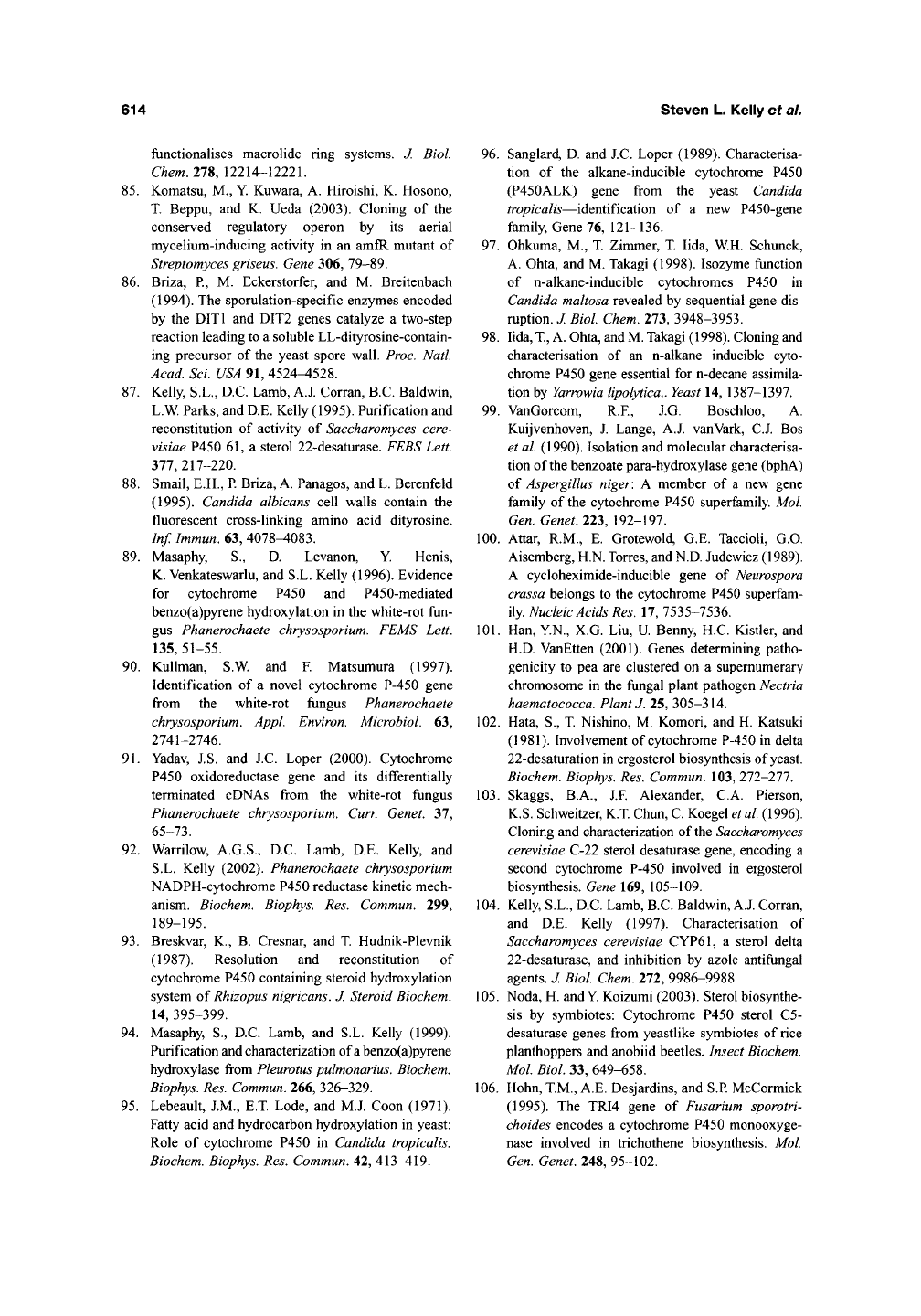
614 Steven L. Kelly ef a/.
functionalises macrolide ring systems. J. Biol.
Chem.nS, 12214-12221.
85.
Komatsu, M., Y. Kuwara, A. Hiroishi, K. Hosono,
T. Beppu, and K. Ueda (2003). Cloning of the
conserved regulatory operon by its aerial
mycelium-inducing activity in an amfR mutant of
Streptomyces griseus. Gene 306, 79-89.
86.
Briza, P., M. Eckerstorfer, and M. Breitenbach
(1994).
The sporulation-specific enzymes encoded
by the DITl and DIT2 genes catalyze a two-step
reaction leading to a soluble LL-dityrosine-contain-
ing precursor of the yeast spore wall. Proc. Natl.
Acad.
Sci. USA 91, 4524-4528.
87.
Kelly, S.L., D.C. Lamb, A.J. Corran, B.C. Baldwin,
L.W. Parks, and D.E. Kelly (1995). Purification and
reconstitution of activity of Saccharomyces cere-
visiae P450 61, a sterol 22-desaturase. FEBS Lett.
311,
217-220.
88.
Small, E.H., P. Briza, A. Panagos, and L. Berenfeld
(1995).
Candida albicans cell walls contain the
fluorescent cross-linking amino acid dityrosine.
Inf. Immun. 63, 4078-4083.
89.
Masaphy, S., D. Levanon, Y. Henis,
K. Venkateswariu, and S.L. Kelly (1996). Evidence
for cytochrome P450 and P450-mediated
benzo(a)pyrene hydroxylation in the white-rot fun-
gus Phanerochaete chrysosporium. FEMS Lett.
135,51-55.
90.
Kullman, S.W. and F. Matsumura (1997).
Identification of a novel cytochrome P-450 gene
from the white-rot fungus Phanerochaete
chrysosporium. Appl. Environ. Microbiol. 63,
2741-2746.
91.
Yadav, J.S. and J.C. Loper (2000). Cytochrome
P450 oxidoreductase gene and its differentially
terminated cDNAs from the white-rot fungus
Phanerochaete chrysosporium. Curr. Genet. 37,
65-73.
92.
Warrilow, A.G.S., D.C. Lamb, D.E. Kelly, and
S.L. Kelly (2002). Phanerochaete chrysosporium
NADPH-cytochrome P450 reductase kinetic mech-
anism. Biochem. Biophys. Res. Commun. 299,
189-195.
93.
Breskvar, K., B. Cresnar, and T. Hudnik-Plevnik
(1987).
Resolution and reconstitution of
cytochrome P450 containing steroid hydroxylation
system of Rhizopus nigricans. J. Steroid Biochem.
14,395-399.
94.
Masaphy, S., D.C. Lamb, and S.L. Kelly (1999).
Purification and characterization of a benzo(a)pyrene
hydroxylase from Pleurotus pulmonarius. Biochem.
Biophys. Res. Commun. 266, 326-329.
95.
Lebeault, J.M., E.T. Lode, and M.J. Coon (1971).
Fatty acid and hydrocarbon hydroxylation in yeast:
Role of cytochrome P450 in Candida tropicalis.
Biochem. Biophys. Res. Commun. 42, 413^19.
96.
Sanglard, D. and J.C. Loper (1989). Characterisa-
tion of the alkane-inducible cytochrome P450
(P450ALK) gene from the yeast Candida
tropicalis—identification of a new P450-gene
family. Gene 76, 121-136.
97.
Ohkuma, M., T. Zimmer, T. lida, W.H. Schunck,
A. Ohta, and M. Takagi (1998). Isozyme function
of n-alkane-inducible cytochromes P450 in
Candida maltosa revealed by sequential gene dis-
ruption. J. Biol. Chem. 273, 3948-3953.
98.
lida,
T.,
A.
Ohta, and
M.
Takagi (1998). Cloning and
characterisation of an n-alkane inducible cyto-
chrome P450 gene essential for n-decane assimila-
tion by
Yarrowia
lipolytica,.
Yeast
14, 1387-1397.
99.
VanGorcom, R.F, J.G. Boschloo, A.
Kuijvenhoven, J. Lange, A.J. vanVark, C.J. Bos
et al. (1990). Isolation and molecular characterisa-
tion of the benzoate para-hydroxylase gene (bphA)
of Aspergillus niger: A member of a new gene
family of the cytochrome P450 superfamily Mol.
Gen.
Genet. 223, 192-197.
100.
Attar, R.M., E. Grotewold, G.E. Taccioli, G.O.
Aisemberg, H.N. Torres, and
N.D.
Judewicz (1989).
A cycloheximide-inducible gene of Neurospora
crassa belongs to the cytochrome P450 superfam-
ily Nucleic Acids Res. 17, 7535-7536.
101.
Han, Y.N., X.G. Liu, U. Benny, H.C. Kistler, and
H.D. VanEtten (2001). Genes determining patho-
genicity to pea are clustered on a supernumerary
chromosome in the ftingal plant pathogen Nectria
haematococca. Plant J. 25, 305-314.
102.
Hata, S., T. Nishino, M. Komori, and H. Katsuki
(1981).
Involvement of cytochrome P-450 in delta
22-desaturation in ergosterol biosynthesis of yeast.
Biochem. Biophys. Res. Commun. 103, 272-277.
103.
Skaggs, B.A., J.F. Alexander, C.A. Pierson,
K.S.
Schweitzer, K.T Chun, C. Koegel
etal.
(1996).
Cloning and characterization of
the Saccharomyces
cerevisiae C-22 sterol desaturase gene, encoding a
second cytochrome P-450 involved in ergosterol
biosynthesis. Gene 169, 105-109.
104.
Kelly S.L., D.C. Lamb, B.C. Baldwin, A.J. Corran,
and D.E. Kelly (1997). Characterisation of
Saccharomyces cerevisiae
CYP61,
a sterol delta
22-desaturase, and inhibition by azole antifimgal
agents. J. Biol. Chem. 272, 9986-9988.
105.
Noda, H. and Y Koizumi (2003). Sterol biosynthe-
sis by symbiotes: Cytochrome P450 sterol C5-
desaturase genes from yeastlike symbiotes of rice
planthoppers and anobiid beetles. Insect Biochem.
Mol. Biol. 33, 649-658.
106.
Hohn, T.M., A.E. Desjardins, and S.P McCormick
(1995).
The TRI4 gene of Fusarium sporotri-
choides encodes a cytochrome P450 monooxyge-
nase involved in trichothene biosynthesis. Mol.
Gen.
Genet. 248, 95-102.
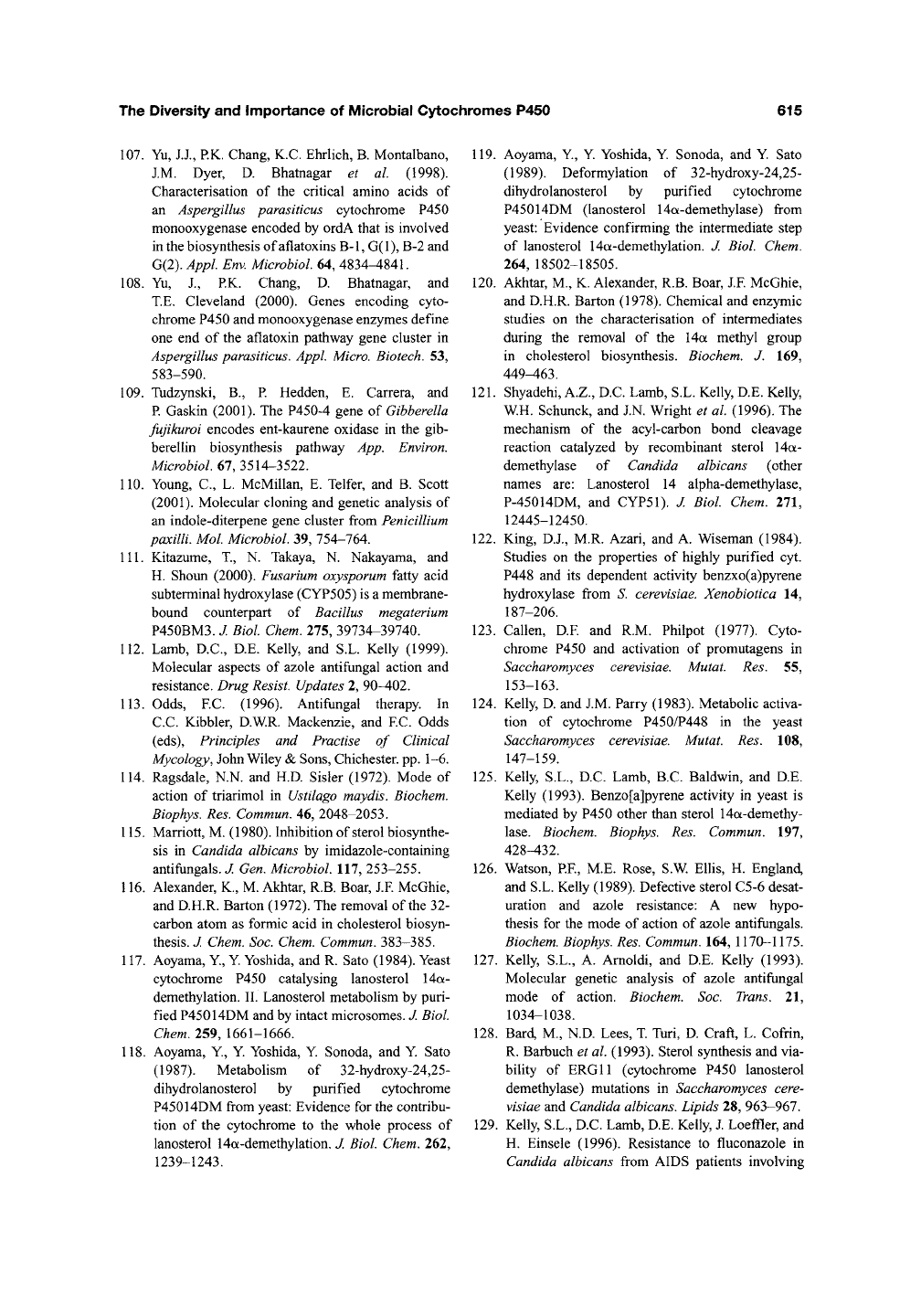
The Diversity and Importance of IVIicrobial Cytochiromes P450 615
107.
Yu, JJ., RK. Chang, K.C. Ehrlich, B. Montalbano,
J.M. Dyer, D. Bhatnagar et al. (1998).
Characterisation of the critical amino acids of
an Aspergillus parasiticus cytochrome P450
monooxygenase encoded by ordA that is involved
in the biosynthesis of aflatoxins
B-1,
G(l), B-2 and
G(2).
Appl Env. Microbiol 64, 4834-4841.
108.
Yu, J., P.K. Chang, D. Bhatnagar, and
T.E. Cleveland (2000). Genes encoding cyto-
chrome P450 and monooxygenase enzymes define
one end of the aflatoxin pathway gene cluster in
Aspergillus parasiticus. Appl. Micro. Biotech. 53,
583-590.
109.
Tudzynski, B., P. Hedden, E. Carrera, and
R Gaskin (2001). The P450-4 gene of Gibberella
fujikuroi encodes ent-kaurene oxidase in the gib-
berellin biosynthesis pathway App. Environ.
Microbiol. 61,3514-3522.
110.
Young, C, L. McMillan, E. Telfer, and B. Scott
(2001).
Molecular cloning and genetic analysis of
an indole-diterpene gene cluster from Penicillium
paxilli. Mol. Microbiol. 39, 754-764.
111.
Kitazume, T., N. Takaya, N. Nakayama, and
H. Shoun (2000). Fusarium oxysporum fatty acid
subterminal hydroxylase (CYP505) is a membrane-
bound counterpart of Bacillus megaterium
P450BM3.
J. Biol. Chem. 275, 39734-39740.
112.
Lamb, D.C., D.E. Kelly, and S.L. Kelly (1999).
Molecular aspects of azole antifungal action and
resistance. Drug Resist. Updates 2, 90-402.
113.
Odds, F.C. (1996). Antifungal therapy. In
C.C. Kibbler, D.W.R. Mackenzie, and F.C. Odds
(eds),
Principles and Practise of Clinical
Mycology, John Wiley & Sons, Chichester, pp. 1-6.
114.
Ragsdale, N.N. and H.D. Sisler (1972). Mode of
action of triarimol in Ustilago maydis. Biochem.
Biophys. Res. Commun. 46, 2048-2053.
115.
Marriott, M. (1980). Inhibition of sterol biosynthe-
sis in Candida albicans by imidazole-containing
antifungals. J. Gen. Microbiol. Ill, 253-255.
116.
Alexander, K., M. Akhtar, R.B. Boar, J.F. McGhie,
and D.H.R. Barton (1972). The removal of the 32-
carbon atom as formic acid in cholesterol biosyn-
thesis.
J. Chem. Soc. Chem. Commun. 383-385.
117.
Aoyama, Y, Y Yoshida, and R. Sato (1984). Yeast
cytochrome P450 catalysing lanosterol 14a-
demethylation. II. Lanosterol metabolism by puri-
fied P45014DM and by intact microsomes. J. Biol.
Chem.
259, 1661-1666.
118.
Aoyama, Y, Y Yoshida, Y Sonoda, and Y Sato
(1987).
Metabolism of 32-hydroxy-24,25-
dihydrolanosterol by purified cytochrome
P45014DM from yeast: Evidence for the contribu-
tion of the cytochrome to the whole process of
lanosterol 14a-demethylation. J. Biol. Chem. 262,
1239-1243.
119.
Aoyama, Y, Y Yoshida, Y Sonoda, and Y Sato
(1989).
Deformylation of 32-hydroxy-24,25-
dihydrolanosterol by purified cytochrome
P45014DM (lanosterol 14a-demethylase) from
yeast: Evidence confirming the intermediate step
of lanosterol 14a-demethylation. J. Biol. Chem.
264,
18502-18505.
120.
Akhtar, M., K. Alexander, R.B. Boar, J.F McGhie,
and D.H.R. Barton (1978). Chemical and enzymic
studies on the characterisation of intermediates
during the removal of the 14a methyl group
in cholesterol biosynthesis. Biochem. J. 169,
449^63.
121.
Shyadehi, A.Z., D.C. Lamb, S.L. Kelly, D.E. Kelly,
W.H. Schunck, and J.N. Wright et al. (1996). The
mechanism of the acyl-carbon bond cleavage
reaction catalyzed by recombinant sterol 14a-
demethylase of Candida albicans (other
names are: Lanosterol 14 alpha-demethylase,
P-45014DM, and CYP51). J. Biol. Chem. Ill,
12445-12450.
122.
King, D.J., M.R. Azari, and A. Wiseman (1984).
Studies on the properties of highly purified cyt.
P448 and its dependent activity benzxo(a)pyrene
hydroxylase from S. cerevisiae. Xenobiotica 14,
187-206.
123.
Callen, D.E and R.M. Philpot (1977). Cyto-
chrome P450 and activation of promutagens in
Saccharomyces cerevisiae. Mutat. Res. 55,
153-163.
124.
Kelly, D. and J.M. Parry (1983). Metabolic activa-
tion of cytochrome P450/P448 in the yeast
Saccharomyces cerevisiae. Mutat. Res. 108,
147-159.
125.
Kelly, S.L., D.C. Lamb, B.C. Baldwin, and D.E.
Kelly (1993). Benzo[a]pyrene activity in yeast is
mediated by P450 other than sterol 14a-demethy-
lase.
Biochem. Biophys. Res. Commun. 197,
428-432.
126.
Watson, RF, M.E. Rose, S.W Ellis, H. England,
and S.L. Kelly (1989). Defective sterol C5-6 desat-
uration and azole resistance: A new hypo-
thesis for the mode of action of azole antifungals.
Biochem. Biophys. Res. Commun. 164, 1170-1175.
127.
Kelly, S.L., A. Amoldi, and D.E. Kelly (1993).
Molecular genetic analysis of azole antifungal
mode of action. Biochem. Soc. Trans. 21,
1034-1038.
128.
Bard, M., N.D. Lees, T. Turi, D. Craft, L. Cofrin,
R. Barbuch et al. (1993). Sterol synthesis and via-
bility of ERG 11 (cytochrome P450 lanosterol
demethylase) mutations in Saccharomyces cere-
visiae and Candida albicans. Lipids 28, 963-967.
129.
Kelly, S.L., D.C. Lamb, D.E. Kelly, J. Loeffler, and
H. Einsele (1996). Resistance to fluconazole in
Candida albicans from AIDS patients involving
